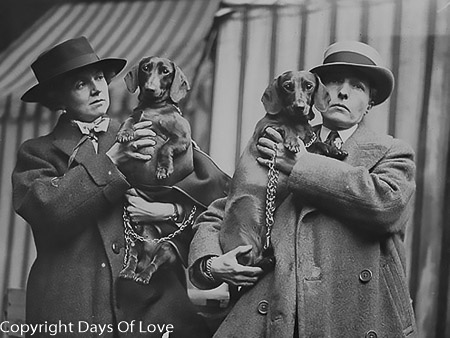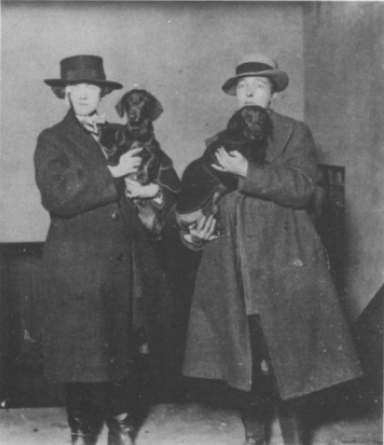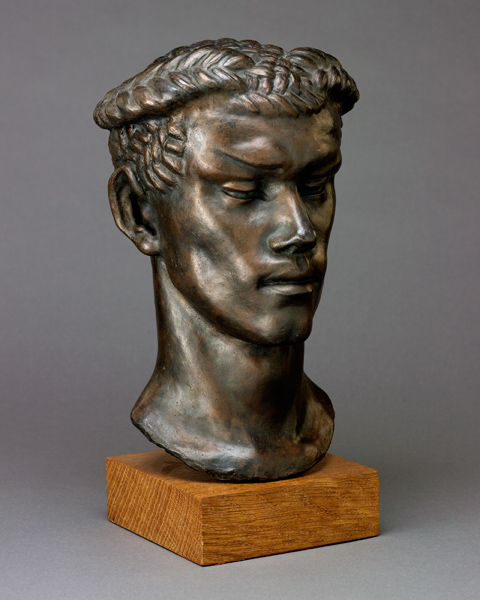

Partner Marguerite John Radclyffe-Hall
Queer Places:
23 Montpelier Square, Knightsbridge, London SW7 1JR, Regno Unito
Royal College of Art, Kensington Gore, Kensington, London SW7 2EU, Regno Unito
13 Royal Hospital Rd, Chelsea, London SW3 4SR, Regno Unito
22 Draycott Ave, Chelsea, London SW3 3AA, Regno Unito
10 Sterling St, Knightsbridge, London SW7 1HN, Regno Unito
7 Trevor Square, Knightsbridge, London SW7 1DT, Regno Unito
37 Holland St, Kensington, London W8 4LX, Regno Unito
The Mermaid Inn, Mermaid St, Rye TN31 7EY, Regno Unito
Santa Maria, West St, Rye TN31 7ES, UK
8 Watchbell St, Rye TN31 7HA, Regno Unito
Black Boy, 4 High St, Rye TN31 7JE, Regno Unito
The Forecastle, Hucksteps Row, Church Square, Rye TN31 7HG, Regno Unito
Campo Cestio, Via Caio Cestio, 6, 00153 Roma RM, Italia
 Una Vincenzo, Lady Troubridge (born Margot Elena Gertrude Taylor; 8 March
1887 – 24 September 1963) was a British sculptor and translator. She is best
known as the long-time lesbian partner of
Marguerite
Radclyffe Hall, author of The Well of Loneliness. Troubridge,
recalling her meeting with ‘John’, as Radclyffe Hall had been named by her
first (female) lover, remembered the ‘rough country clothes; heavy
short-skirted tweeds unusual in those days, collars and ties and … a queer
little green Heath hat’. Troubridge herself was monocled and shingled and wore
trousers. Djuna Barnes wrote a
lively bagatelle called Ladies Almanack in 1928.
Natalie Barney
featured here as Dame Evangeline Musset;
Romaine Brooks as Cynic Sal;
Lily de Gramont as the
Duchesse Clitoressa of Natescourt;
Una Troubridge as Lady
Buck-and-Balk; Radclyffe Hall as
Tilly Tweed-in-blood; Mina Loy as
Patience Scalpel; Mimì Franchetti
as Senorita Fly-About; and Janet
Flanner and Solita Solano as
Nip and Tuck. The book was privately published by
Robert McAlmon.
Una Vincenzo, Lady Troubridge (born Margot Elena Gertrude Taylor; 8 March
1887 – 24 September 1963) was a British sculptor and translator. She is best
known as the long-time lesbian partner of
Marguerite
Radclyffe Hall, author of The Well of Loneliness. Troubridge,
recalling her meeting with ‘John’, as Radclyffe Hall had been named by her
first (female) lover, remembered the ‘rough country clothes; heavy
short-skirted tweeds unusual in those days, collars and ties and … a queer
little green Heath hat’. Troubridge herself was monocled and shingled and wore
trousers. Djuna Barnes wrote a
lively bagatelle called Ladies Almanack in 1928.
Natalie Barney
featured here as Dame Evangeline Musset;
Romaine Brooks as Cynic Sal;
Lily de Gramont as the
Duchesse Clitoressa of Natescourt;
Una Troubridge as Lady
Buck-and-Balk; Radclyffe Hall as
Tilly Tweed-in-blood; Mina Loy as
Patience Scalpel; Mimì Franchetti
as Senorita Fly-About; and Janet
Flanner and Solita Solano as
Nip and Tuck. The book was privately published by
Robert McAlmon.
After meeting Una Troubridge in 1915, Radclyffe Hall discovered the happy irony that there could be greater freedom in a lesbian relationship than in a sanctioned alliance.
As a financially independent woman, Radclyffe Hall could afford to risk social disapproval by being open about her sexuality, and she began to do so as soon as she reached maturity. However, it was not until 1918, when she began her lifelong relationship with Una Vincenzo, Lady Troubridge, the former wife of Lord Admiral Troubridge, that Hall's lesbianism became notorious. As the wife of an admiral, Una Troubridge held an important social position, and her desertion of her husband for a woman inevitably caused a scandal.

Una Vincenzo by Romaine Brooks, 1924

Private View (1937) by Gladys Hines.

Radclyffe Hall and Una Troubridge at the Ladies' Kennel Club Dog Show,
Ranelagh, 1920

Radclyffe Hall and Una Troubrigde at Crufts, 1923

Vaslav Nijinsky as the faun from L'apres-midi d'un faune, by Una
Troubridge, 1912
Una Troubridge was an educated woman with achievements in her own right. Most notably she was a successful translator and introduced the French writer Colette to English readers. Her talent as a sculptor prompted Vaslav Nijinsky to sit for her several times.[1]
Born Margot Elena Gertrude Taylor, she was the daughter of Capt. Henry (or Harry) A. Taylor. She was nicknamed Una by her family as a child and chose the middle name Vincenzo herself, after her Florentine relatives.[2] She was raised in Montpelier Square, London, and became a pupil at the Royal College of Art, and after she graduated set up a sculpture studio. Her father died in 1907, leaving her with limited financial support, and marriage became her best practical option.
She married Captain Ernest Troubridge in October 1908; they had one daughter, Andrea Theodosia Troubridge (1910-1966) who married Theodore Egerton Nicholson Warren, son of Sir Norcott Hastings Yeeles Warren, and later Douglas John Tullock Turnbull.[3] Ernest Troubridge rose to the rank of admiral during and immediately after the First World War, and Una gained her title when Admiral Troubridge was knighted in June 1919, although they were already legally separated at the time.[2] Andrea Troubridge was born on November 5, 1910 in St George Hanover Square, London, England as Andrea Theodosia Troubridge. She was an actress, known for The House in the Woods (1957), ITV Play of the Week (1955) and Deirdre (1938). She died on October 4, 1966 in Kencot, Oxfordshire, England.
Una was a devoted admirer of the Italian-Russian operatic bass Nicola Rossi-Lemeni [1920-1991], and followed his career all over the world. She later became a close friend of both Rossi-Lemeni and his wife, the soprano Virginia Zeani, and was godmother to their young son.
Hall and Troubridge met in 1915 as Troubridge's cousin, singer Mabel Batten (aka Ladye), was Hall's lover at the time. Batten died in 1916, and Hall and Troubridge moved in together the following year. In the early 1920s, Troubridge and Hall's home was at 10 Stirling Street, London, near where Troubridge had grown up. The property was extensively renovated by the two.[4] She wrote about the intensity of their relationship in her diary: "I could not, having come to know her, imagine life without her."[5][6]
In an effort to ease the great sense of guilt about Mabel's death Hall and Troubridge became interested in spiritualism. They regularly held seances with the use of a medium and believed that they received advice from Mabel, from beyond the grave.[7] Both Troubridge and Hall identified as "inverts",[8] a term used by sexologists such as Krafft-Ebing and Havelock Ellis usually to connote what is regarded as homosexuality.
The couple raised and showed dachshunds and griffons. The dachshunds shown in the Romaine Brooks portrait of Troubridge were a prize-winning pair given to her by Hall.[9] In the last nine years of her life Hall had become obsessed with a White Russian nurse, Evgenia Souline, a relationship which caused Troubridge unhappiness, but which she nonetheless tolerated. Initially the women had decided to move to Italy and live in Florence, but were forced to return at the outbreak of WWII. The three chose to live in Devon.
When Mary Allen and Helen Tagart were introduced to Radclyffe Hall and Una Troubridge in 1930, Troubridge recorded in her diary that Allen thought "the authorities were against her because she was an invert."
Despite all their troubles, Troubridge stayed with Hall and nursed her until she died in 1943. In the early 1920s Troubridge adopted a tailored style similar to Hall's own masculine look, as a way of making her sexual identity and their partnership visible. Later she came to prefer more feminine dress that complemented Hall's.[10] After Hall died of bowel cancer in 1943, Troubridge had Hall's suits altered to fit her and wore them habitually.[11]
On her deathbed, Hall revoked a previous will that had provided Souline with an income, and instead left everything to Troubridge, including the copyrights to her works. In her new will she asked Troubridge to "make such provision for our friend Eugenie Souline as in her absolute discretion she may consider right"; Troubridge provided Souline with only a small allowance. She burned Souline's letters. In her 1945 biography, The Life and Death of Radclyffe Hall, she minimized Souline's role in Hall's life.[12] Souline died in 1958.
Troubridge died in Rome in 1963; she had left written instructions that her coffin be placed in the vault in Highgate Cemetery where Hall and Batten had been buried, but the instructions were discovered too late.[13] She was buried in the English Cemetery in Rome, and on her coffin is inscribed "Una Vincenzo Troubridge, the friend of Radclyffe Hall". Recently her tomb was removed, and her remains got lost.
My published books: